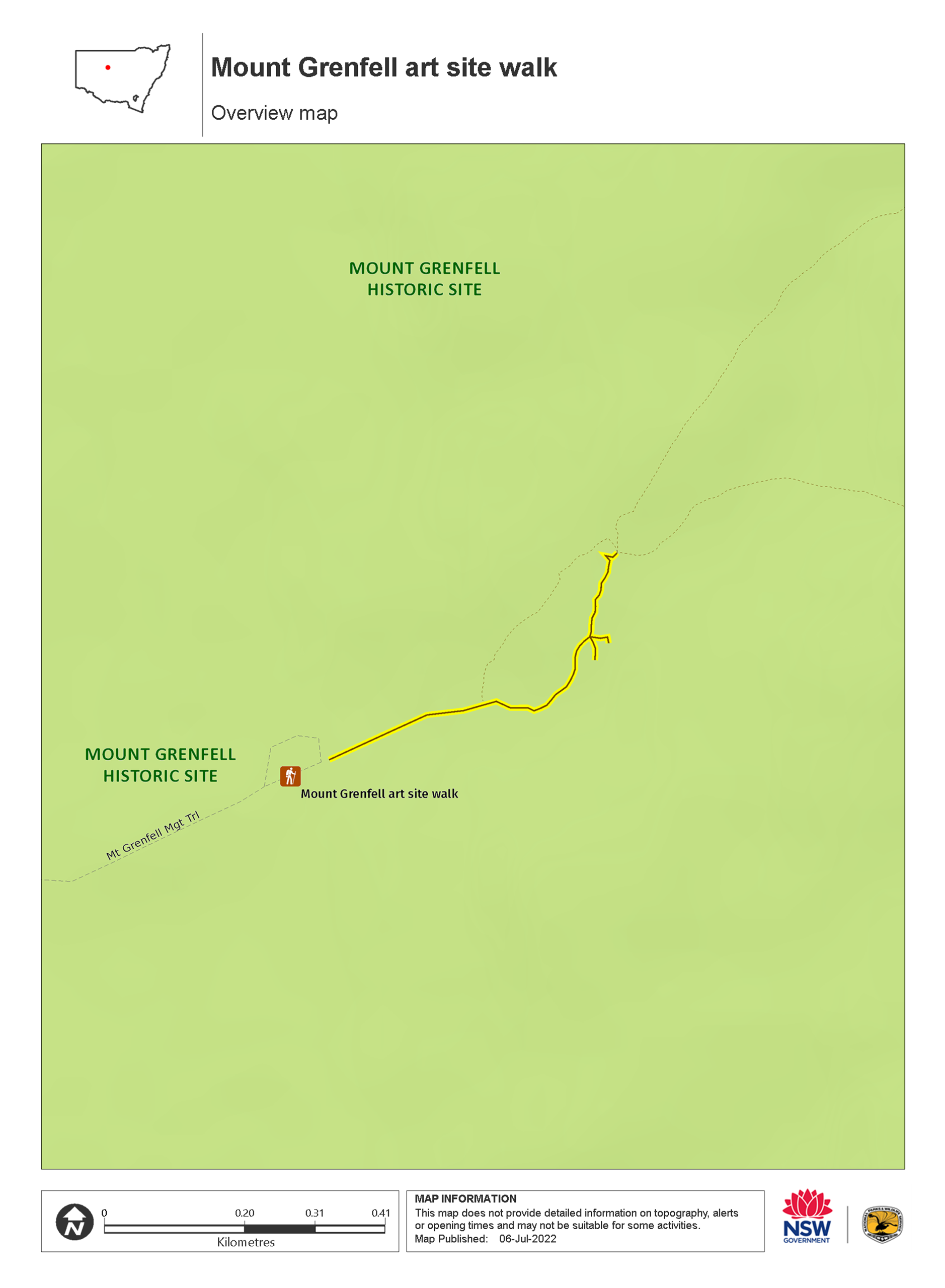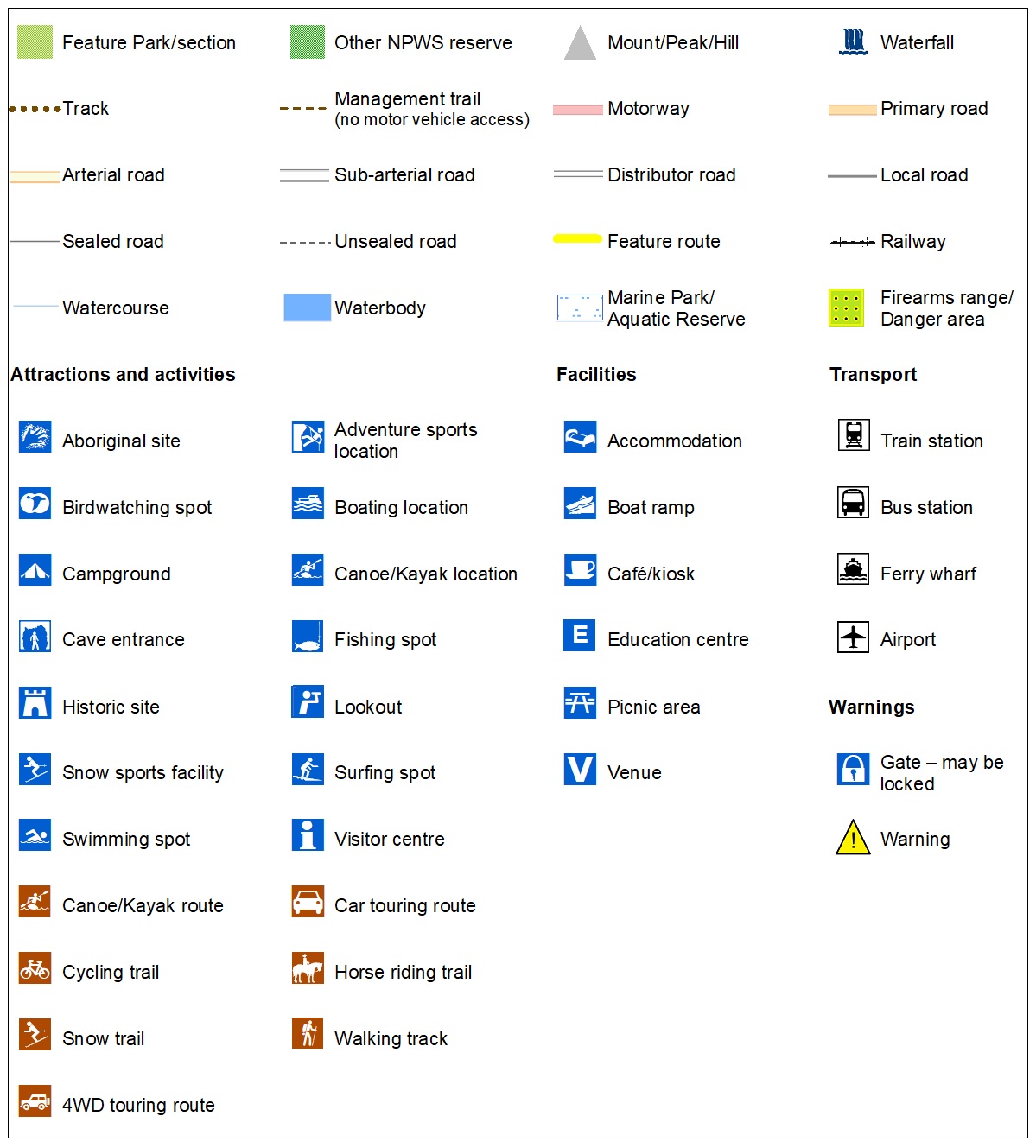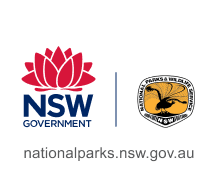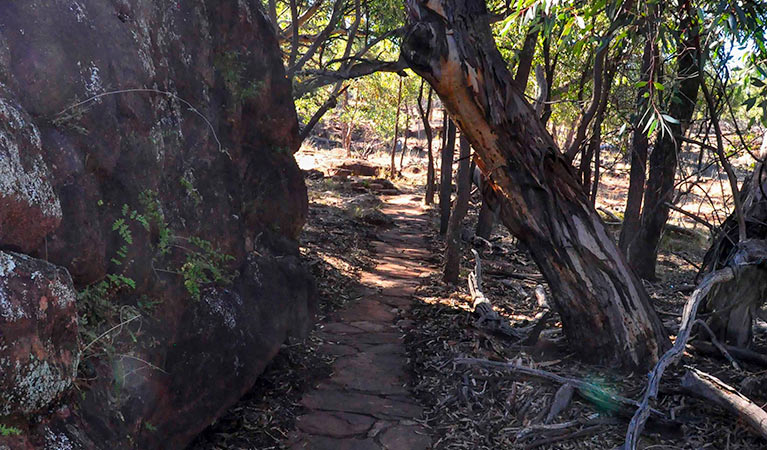Overview
From the picnic area, it’s a short easy stroll along Mount Grenfell art site walk to view Aboriginal rock art, which continues to be deeply significant to Ngiyampaa People.
- Where
- Mount Grenfell Historic Site in Outback NSW
- Accessibility
- Medium
- Distance
- 3km return
- Time suggested
- 1hr 30min - 2hrs 30min
- Grade
- Grade 3
- What to
bring - Drinking water, hat, sunscreen
On the rocky overhangs of Mount Grenfell art site walk are human figures, animals, medicine, waterways, land, and Dreaming stories depicted in red, yellow, and ochre pigment, applied with a finger or brush. Ochres come from naturally tinted clay and are some of the earliest pigments used by humans. You’ll also see stencils created by blowing a mouthful of pigment over a hand held against the rock face.
It’s only a short, easy walk to view three galleries of this spectacular Aboriginal rock art, which have been layered upon each other over time. The site holds particular significance for Ngiyampaa People, who are traditional owners of this land.
Take your time on this walking route past mallee and cypress pines. Sit and listen to birdcalls, and imagine people gathering here at this meeting place from the surrounding area to talk, laugh, argue, pass on knowledge, record information and take part in ceremonies.
Map

Map legend

Local alerts
For the latest updates on fires, closures and other alerts in this area, see https://www.nationalparks.nsw.gov.au/things-to-do/walking-tracks/mount-grenfell-art-site-walk/local-alerts
General enquiries
- National Parks Contact Centre
- 7am to 7pm daily
- 1300 072 757 (13000 PARKS) for the cost of a local call within Australia excluding mobiles
- parks.info@environment.nsw.gov.au
Park info
- in Mount Grenfell Historic Site in the Outback NSW region
Mount Grenfell Historic Site is always open but may have to close at times due to poor weather, fire danger or cultural activities.
Visitor info
All the practical information you need to know about Mount Grenfell art site walk.
Track grading
Features of this track
Distance
3km return
Time
1hr 30min - 2hrs 30min
Quality of markings
Sign posted
Experience required
No experience required
Gradient
Short steep hills
Steps
Occasional steps
Quality of path
Formed track, some obstacles: The walk begins as a 4m-wide 2WD trail and becomes a 1m-wide hard-packed ground walking track roughly 280m along.
Getting there and parking
On entering Mount Grenfell Historic Site:
- From the picnic area, walk past the locked gate and continue up the road towards the hill.
- Look for a green sign showing the way to the walking track
- Follow the stone path to the three art sites
Road quality
Check the weather before you set out as the road to Mount Grenfell Historic Site can become boggy when it rains.
Parking
There's parking in a gravel carpark at the start of the walk. Bus parking is available.
Best times to visit
There are lots of great things waiting for you in Mount Grenfell Historic Site. Here are some of the highlights.
Spring
White mallee flowers are blooming and birdwatching is at its best during this season.
Winter
This is ideal weather for hiking Ngiyambaa walking track.
Weather, temperature and rainfall
Summer temperature
Average
20°C and 33°C
Highest recorded
47°C
Winter temperature
Average
5.5°C and 16.5°C
Lowest recorded
-2.5°C
Rainfall
Wettest month
January
Driest month
June
The area’s highest recorded rainfall in one day
109mm
Facilities
Drinking water is not available in this area, so it’s a good idea to bring your own.
Toilets
There are accessible toilets at the picnic area where this walk begins.
There are also toilets at the rest area roughly halfway along the track. These toilets are not accessible or ambulant.
Picnic tables
There are picnic tables at the picnic area where this walk begins. There's also a picnic table at the rest area around halfway along the walk.
Seats and resting points
There are benches with backrests in shaded areas for resting.
Maps and downloads
Accessibility
Disability access level - medium
- Mount Grenfell art site walk begins as a 4m-wide hard-packed ground 2WD trail, and narrows to a 1m-wide hard-packed ground walking track after roughly 280m.
- There's a rest area mid-way along the walk with picnic tables and toilets, but the toilets are not accessible or ambulant.
- There are other toilets which are accessible at the start of the walk, along with picnic tables and bench seats for resting.
Prohibited
Pets
Pets and domestic animals (other than certified assistance animals) are not permitted. Find out which regional parks allow dog walking and see the pets in parks policy for more information.
Smoking
NSW national parks are no smoking areas.
Learn more
Mount Grenfell art site walk is in Mount Grenfell Historic Site. Here are just some of the reasons why this park is special:
Living off the land

Emus and kangaroos inhabit Mount Grenfell and, on warmer days, you’re likely to see bearded dragons, shinglebacks and geckos. Keep a careful eye out too for endangered kultarr (also known as jerboa pouched-mouse, wuhl-wuhl or pitchi-pitchi), which can best be described as a mouse that hops. While you’re looking down for a pitchi-pitchi, you may also see a red-capped robin rifling through the leaf litter. This bird is often part of a mixed species feeding flock with other similarly sized birds such as thornbills, which also inhabit the park.
Making a scene

At Mount Grenfell, art featuring all facets of Aboriginal life covers rocky overhangs surrounding the park’s waterhole. Many are linear paintings done by applying wet pigment with a fingertip or natural brush. Others are hand stencils. In some places, ochre and white pipeclay have been applied thickly and left to dry. More recent paintings have been superimposed over older ones. There are stick figures, human figures, images of birds and animals, medicine, food, the landscape and dreaming stories. This art remains deeply significant to Ngiyampaa people.
Ngiyampaa: Past, present and future

The Ngiyampaa (pronounced nee-yam-par) are dryland people associated with the arid plains and rocky hill country of Central West NSW bordered roughly by Lachlan, Darling-Barwon and Bogan Rivers. The semi-permanent waterhole at Mount Grenfell was an important meeting place for generation after generation of this Aboriginal group. Following European settlement, however, Ngiyampaa people were moved to stations northwest of Wiradjuri country and in the 1930s, many were relocated again to Murrin Bridge near Lake Cargelligo. On 17 July 2004, Mount Grenfell was handed back to traditional owners and is now jointly managed with NSW NPWS. Ngiyampaa people maintain strong connections with this area and continue to pass on cultural knowledge.

